739. Crimson-breasted Shrike (Formerly known as Crimson-breasted Boubou) Laniarius atrococcineus (Rooiborslaksman)
Order: Passeriformes. Family: Malaconotidae
Description
22 cm. The head, bill and back are black with a white wing bar while the underparts are entirely scarlet.
The sexes are alike. A yellow-breasted form is occasionally seen. Young birds have a mottled and barred buff-brown appearance with a pale bill.
Distribution
Angola; Botswana; Namibia; northern areas of South Africa; Zambia; western Zimbabwe.
Habitat
It prefers arid habitats (Kalahari thornveld, Acacia savanna and semi-arid scrub).
Diet
Mainly insects (ants, beetles, caterpillars), often foraging on the ground for ants or fallen fruit.
Breeding
Monogamous. Both sexes construct the nest, which is a tidy cup made almost entirely of Acacia tree bark, collected from trunks and branches about 50-90 m from the nesting site and lined with grass and rootlets. It is usually bound with spider web to a fork in the main stem of a plant, or occasionally onto a horizontal branch. Most of the construction work is done in the early morning, and it is usually complete after about 4-6 days. Egg-laying season is from August-January, peaking from October-November. It lays 2-3 eggs, which are incubated by both sexes for about 15-17 days. The chicks are fed and brooded by both parents, leaving the est at about 18-20 days old. Although they forage independently, they stil come back to roost with their parents, sometimes only leaving in next years breeding season.
Parasitised by Black Cuckoo.
Call
The main call is loud and fast tyo-tyo or quip-quip and variations thereof, either solo or in duet. Listen to bird Call.
Status
Common resident. Near-endemic, sedentary and usually found singly or in pairs.
Africa Wild Bird Book
Crimson-breasted Shrike Photos
739. Crimson-breasted Shrike Laniarius atrococcineus
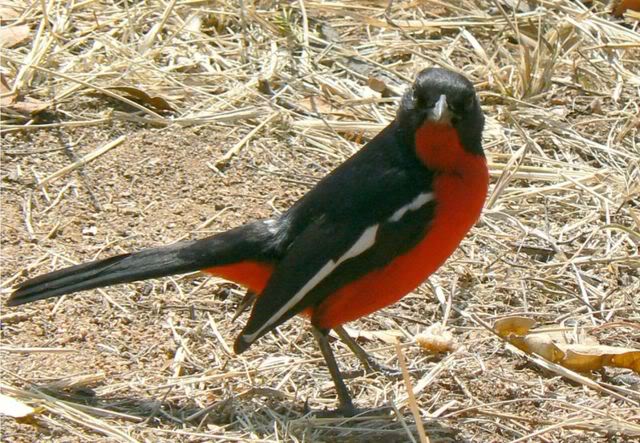

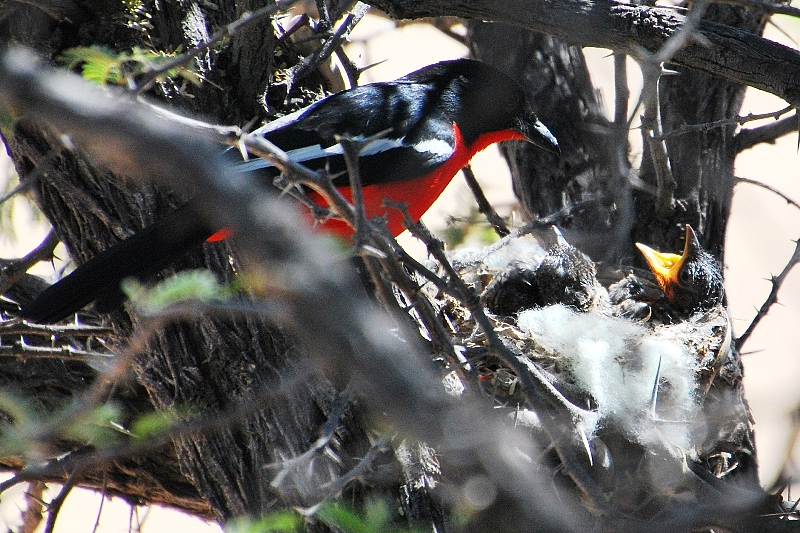 © Mel
© Mel
 © Mel
© Mel
 © Mel
© Mel
The rare yellow morph.
 © Dindingwe
© Dindingwe
Hwange National Park, Zimbabwe
Links:
Sabap2
http://oops.uni-oldenburg.de/1471/1/heufun12.pdf


 © Mel
© Mel © Mel
© Mel © Mel
© MelThe rare yellow morph.
Hwange National Park, Zimbabwe
Links:
Sabap2
http://oops.uni-oldenburg.de/1471/1/heufun12.pdf
Brubru
741. Brubru Nilaus afer (Bontroklaksman)
Order: Passeriformes. Family: Malaconotidae
Description
15 cm. A small, black and white Bush-Shrike with russet flanks.
Adult male: Crown black, colour extending forwards as narrow triangle to base of bill. Supercilia white, broad and long, almost meeting on forehead and extending back to nape. Lores white, with blackish loral spot in front of eye. Ear coverts black, extending back to black nape. Mantle black laterally, buffy white centrally; scapulars white. Back black, with large white spots along midline. Rump feathers with grey bases, large white subterminal patches, and black tips; long and fluffy. Upper tail coverts black. Tail black, outer rectrices tipped white. Primary coverts black, each with large white oval patch along inner web. Greater coverts black, three innermost feathers with broad white to cream outer margins and tips. Median coverts cream to white, lesser coverts black. Primaries black, with narrow white edges; secondaries and tertials black, but 3 inner secondaries with broad white outer margins. White in wing forms conspicuous bar on folded wing. Undersides of flight feathers grey, with white inner margins. Underwing coverts and axillaries white. Underparts white, with chestnut patches from sides of breast to lower flanks. Bill black, hooked; upper mandible with prominent notch. Eyes dark reddish brown. Legs and feet grey.
Adult female: As ad male, but black of upper parts replaced with brown. Chin, throat and upper breast with blackish streaking. Chestnut breast patches smaller; flanks pale rufous.
The juvenile is mottled brown, buff and white above, with buff edgings to the wing and tail feathers. Its underparts are whitish with brown barring.
The underparts are white and it has rufous flanks.
Similar species: Size, thick bill and broad, straight white eyebrow stripe should prevent confusion with smaller batises. Batises with yellow or orange (not dark) eyes; no batis has such a broad and long supercilium. Black-backed Puffback larger, with underparts wholly white.
Distribution
Widespread in sub-Saharan Africa, absent only from the southern half of South Africa (including the Western, Eastern and Northern Capes) and the lowland forest in and around the DRC and West African coast.
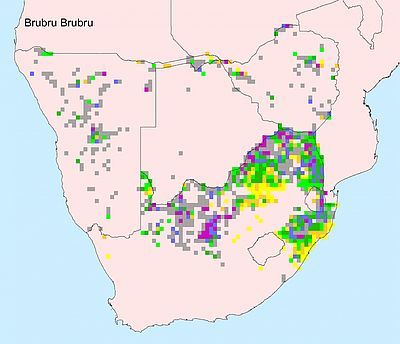
Habitat
Thornveld and broad leaf woodland. Found in the canopy of preferred trees. In southern Africa it generally prefers Acacia savanna, Miombo woodland and Mopane woodland, occasionally occurring in more arid habitats.
Diet
Insects including moths, spiders, caterpillars, beetles, grasshoppers & flies. It gleans insects from the leaves and twigs in the upper and mid canopy of large trees. It will occasionally hawk insects in mid-air.
Breeding
Brubrus are monogamous. Both sexes build the nest, which is a small, neat cup made of fine plant material such as twigs, tendrils and bark held together with spider web. Egg-laying season is from about August-January. The female lays a clutch of two or three greenish eggs that are blotched with green or brown, eggs are incubated by both sexes for about 19 days. The chicks are brooded constantly for the first week of their lives, after which brooding periods become more and more sporadic. The chicks eventually leave the nest at about 20-22 days old, becoming fully independent roughly 8 weeks later.
Call
The call of the male, usually made from a perch high up in a tree, is a loud tippy-tip-prrrrreeeeeee, and pairs may call in duet, with the female responding to the male’s call with a softer eeeu. Listen to Bird Call.
Status
Common Resident; sedentary.
Order: Passeriformes. Family: Malaconotidae
Description
15 cm. A small, black and white Bush-Shrike with russet flanks.
Adult male: Crown black, colour extending forwards as narrow triangle to base of bill. Supercilia white, broad and long, almost meeting on forehead and extending back to nape. Lores white, with blackish loral spot in front of eye. Ear coverts black, extending back to black nape. Mantle black laterally, buffy white centrally; scapulars white. Back black, with large white spots along midline. Rump feathers with grey bases, large white subterminal patches, and black tips; long and fluffy. Upper tail coverts black. Tail black, outer rectrices tipped white. Primary coverts black, each with large white oval patch along inner web. Greater coverts black, three innermost feathers with broad white to cream outer margins and tips. Median coverts cream to white, lesser coverts black. Primaries black, with narrow white edges; secondaries and tertials black, but 3 inner secondaries with broad white outer margins. White in wing forms conspicuous bar on folded wing. Undersides of flight feathers grey, with white inner margins. Underwing coverts and axillaries white. Underparts white, with chestnut patches from sides of breast to lower flanks. Bill black, hooked; upper mandible with prominent notch. Eyes dark reddish brown. Legs and feet grey.
Adult female: As ad male, but black of upper parts replaced with brown. Chin, throat and upper breast with blackish streaking. Chestnut breast patches smaller; flanks pale rufous.
The juvenile is mottled brown, buff and white above, with buff edgings to the wing and tail feathers. Its underparts are whitish with brown barring.
The underparts are white and it has rufous flanks.
Similar species: Size, thick bill and broad, straight white eyebrow stripe should prevent confusion with smaller batises. Batises with yellow or orange (not dark) eyes; no batis has such a broad and long supercilium. Black-backed Puffback larger, with underparts wholly white.
Distribution
Widespread in sub-Saharan Africa, absent only from the southern half of South Africa (including the Western, Eastern and Northern Capes) and the lowland forest in and around the DRC and West African coast.

Habitat
Thornveld and broad leaf woodland. Found in the canopy of preferred trees. In southern Africa it generally prefers Acacia savanna, Miombo woodland and Mopane woodland, occasionally occurring in more arid habitats.
Diet
Insects including moths, spiders, caterpillars, beetles, grasshoppers & flies. It gleans insects from the leaves and twigs in the upper and mid canopy of large trees. It will occasionally hawk insects in mid-air.
Breeding
Brubrus are monogamous. Both sexes build the nest, which is a small, neat cup made of fine plant material such as twigs, tendrils and bark held together with spider web. Egg-laying season is from about August-January. The female lays a clutch of two or three greenish eggs that are blotched with green or brown, eggs are incubated by both sexes for about 19 days. The chicks are brooded constantly for the first week of their lives, after which brooding periods become more and more sporadic. The chicks eventually leave the nest at about 20-22 days old, becoming fully independent roughly 8 weeks later.
Call
The call of the male, usually made from a perch high up in a tree, is a loud tippy-tip-prrrrreeeeeee, and pairs may call in duet, with the female responding to the male’s call with a softer eeeu. Listen to Bird Call.
Status
Common Resident; sedentary.
Dewi
What is the good of having a nice house without a decent planet to put it on? (H D Thoreau)
What is the good of having a nice house without a decent planet to put it on? (H D Thoreau)
Brubru Photos
741. Brubru Nilaus afer
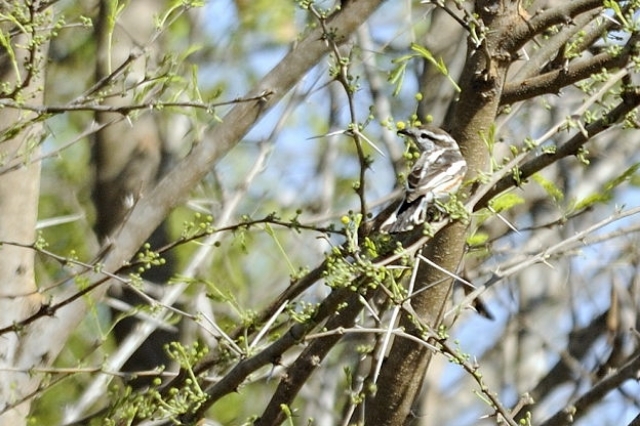 © Dewi
© Dewi
Kruger National Park, S56
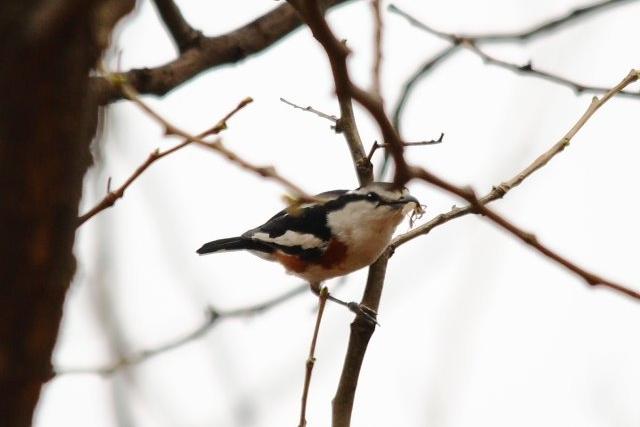 © Flutterby
© Flutterby
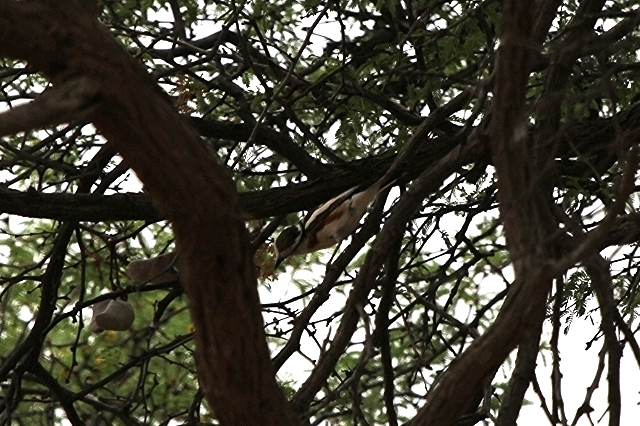 © Tina
© Tina
Kgalagadi Transfrontier Park, South of Houmoed
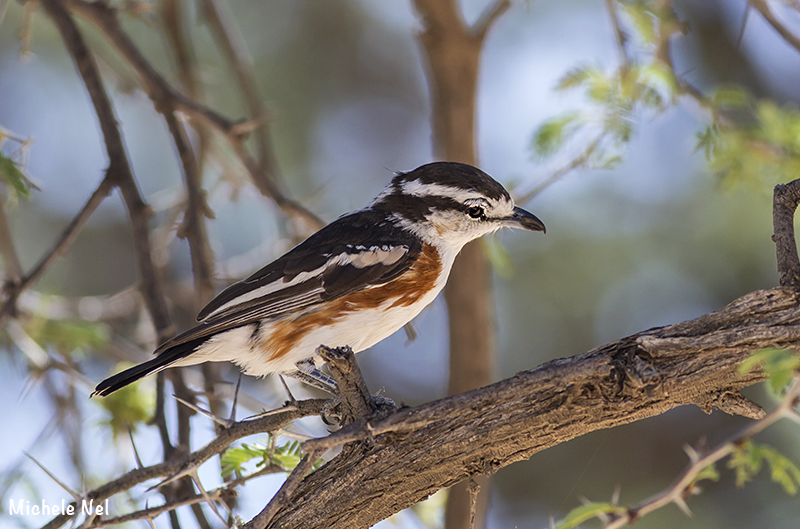
Kgalagadi Transfrontier Park, Mata Mata Camp © Michele Nel
Links:
Species text in The Atlas of Southern African Birds
Sabap2
 © Dewi
© DewiKruger National Park, S56
 © Flutterby
© Flutterby © Tina
© TinaKgalagadi Transfrontier Park, South of Houmoed

Kgalagadi Transfrontier Park, Mata Mata Camp © Michele Nel
Links:
Species text in The Atlas of Southern African Birds
Sabap2
Dewi
What is the good of having a nice house without a decent planet to put it on? (H D Thoreau)
What is the good of having a nice house without a decent planet to put it on? (H D Thoreau)
Family Campephagidae (Cuckooshrikes)
The cuckooshrikes and allies in the Campephagidae family are small to medium-sized passerine bird species found in the subtropical and tropical Africa, Asia and Australasia. The roughly 85 species are found in eight (or nine) genera which comprise five distinct groups, the 'true' cuckooshrikes (Campephaga, Coracina, Lobotos, Pteropodocys and Campochaera) the trillers (Lalage), the minivets (Pericrocotus), the flycatcher-shrikes (Hemipus).
Cuckooshrikes are closely related neither to the cuckoos nor to the shrikes; the name probably comes from the grey colour of many of the cuckooshrikes. They are in fact thought by some to be closely related to the Old World orioles (Oriolidae), although they differ strongly in some morphological characteristics (such as skull morphology and the arrangements of feathers on the wing).
Overall the cuckooshrikes are medium to small arboreal birds, generally long and slender. They are predominantly greyish with white and black, although the Blue Cuckooshrike of central Africa is all-over glossy blue. The four cuckooshrikes in the genus Campephaga exhibit sexual dimorphism, with males that have glossy black plumage and bright red or yellow wattles, the females having more subdued olive-green plumage. The genus Coracina is not monophyletic.
Of the 84 species of cuckooshrike, the majority are forest birds.
The 'true' cuckooshrikes are usually found singly, in pairs, and in small family groups, whereas the minivets, flycatcher-shrikes and wood-shrikes more frequently form small flocks.
They are mainly insectivorous, and will take large hairy caterpillars. They have also been recorded eating small vertebrates, and some fruit, seeds and other plant matter.
In all the species studied the cuckooshrikes are territorial; in species that do not migrate these territories are maintained year round. Cuckooshrikes are monogamous, with the pair bonds apparently lasting throughout the year. Several species of cuckooshrike exhibit cooperative breeding. About four blotchy white, green or blue eggs are laid in a cup nest in a tree. Incubation is about two weeks.
Cuckooshrikes are closely related neither to the cuckoos nor to the shrikes; the name probably comes from the grey colour of many of the cuckooshrikes. They are in fact thought by some to be closely related to the Old World orioles (Oriolidae), although they differ strongly in some morphological characteristics (such as skull morphology and the arrangements of feathers on the wing).
Overall the cuckooshrikes are medium to small arboreal birds, generally long and slender. They are predominantly greyish with white and black, although the Blue Cuckooshrike of central Africa is all-over glossy blue. The four cuckooshrikes in the genus Campephaga exhibit sexual dimorphism, with males that have glossy black plumage and bright red or yellow wattles, the females having more subdued olive-green plumage. The genus Coracina is not monophyletic.
Of the 84 species of cuckooshrike, the majority are forest birds.
The 'true' cuckooshrikes are usually found singly, in pairs, and in small family groups, whereas the minivets, flycatcher-shrikes and wood-shrikes more frequently form small flocks.
They are mainly insectivorous, and will take large hairy caterpillars. They have also been recorded eating small vertebrates, and some fruit, seeds and other plant matter.
In all the species studied the cuckooshrikes are territorial; in species that do not migrate these territories are maintained year round. Cuckooshrikes are monogamous, with the pair bonds apparently lasting throughout the year. Several species of cuckooshrike exhibit cooperative breeding. About four blotchy white, green or blue eggs are laid in a cup nest in a tree. Incubation is about two weeks.
Family Campephagidae (Cuckooshrikes) Index
Family Campephagidae Cuckooshrikes
Coracina caesia Grey Cuckooshrike 540
Coracina pectoralis White-breasted Cuckooshrike 539
Campephaga flava Black Cuckooshrike 538
Coracina caesia Grey Cuckooshrike 540
Coracina pectoralis White-breasted Cuckooshrike 539
Campephaga flava Black Cuckooshrike 538
- nan
- Posts: 26476
- Joined: Thu May 31, 2012 9:41 pm
- Country: Switzerland
- Location: Central Europe
- Contact:
Black Cuckooshrike
538. Black Cuckooshrike Campephaga flava (Swartkatakoeroe)
Order: Passeriformes. Family: Campephagidae

Female
Description
Size 18-21 cm. Small to medium-sized cuckooshrike with fairly long tail.
Adult male: Plumage, bill, eyes and legs are black. The gape is bright orange and the tail is rounded.
The male has two colour forms: one has a variable amount of yellow on its lesser wing coverts, noticeable as a yellow patch in the carpal area; the other is an all-black bird.
Adult female: Upperparts olive, finely barred black. Tail brown and yellow, wings with yellow and blackish markings. Underparts white, finely scalloped black.
Juvenile resembles female.
Similar species: Especially in the drier woodland areas where all-black males predominate, there is a possibility of confusion with the Fork-tailed Drongo and Square-tailed Drongo and the Black Flycatcher. Male differs from Southern Black Flycatcher and Square-tailed Drongo in having a rounded tail, and by its habit of quietly creeping through the tree canopy (not dashing after insects in flight).
Female is similar to a female Chrysococcyx cuckoo but is larger and more barred below, and has bright yellow outer tail feathers.
Distribution
Mainly occurs in Africa south of the equator from southern Sudan, Kenya and the DRC down to southern Africa. Here it is generally uncommon, occupying much of Zimbabwe, Mozambique, Swaziland, northern and south-eastern Botswana and northern Namibia. In South Africa it can be found across the Kruger National Park and eastern KwaZulu-Natal, extending down the coast to the south-western cape.
Habitat
Mature woodland and forest margins.
Diet
It mainly eats insects, getting most of its prey by gleaning leaves and branches, often joining mixed species foraging flocks.
Breeding
Monogamous and territorial. The nest is built solely by the female and consists of a cup built of of moss, lichens and old-man's beard lichen (Usnea) bound together with spider web. It is usually placed in a vertical fork of a tree branch, often high up in the tree. It lays 1-3 eggs, which are incubated by the female for about 20 days - the male feeding her at the nest. The chicks are fed by both adults but brooded only by the female, leaving the nest after about 20-23 days.
Call
A high-piched, prolonged trrrrrrrrrr. Listen to Bird Call.
Status
Locally common resident and summer visitor.
Order: Passeriformes. Family: Campephagidae

Female
Description
Size 18-21 cm. Small to medium-sized cuckooshrike with fairly long tail.
Adult male: Plumage, bill, eyes and legs are black. The gape is bright orange and the tail is rounded.
The male has two colour forms: one has a variable amount of yellow on its lesser wing coverts, noticeable as a yellow patch in the carpal area; the other is an all-black bird.
Adult female: Upperparts olive, finely barred black. Tail brown and yellow, wings with yellow and blackish markings. Underparts white, finely scalloped black.
Juvenile resembles female.
Similar species: Especially in the drier woodland areas where all-black males predominate, there is a possibility of confusion with the Fork-tailed Drongo and Square-tailed Drongo and the Black Flycatcher. Male differs from Southern Black Flycatcher and Square-tailed Drongo in having a rounded tail, and by its habit of quietly creeping through the tree canopy (not dashing after insects in flight).
Female is similar to a female Chrysococcyx cuckoo but is larger and more barred below, and has bright yellow outer tail feathers.
Distribution
Mainly occurs in Africa south of the equator from southern Sudan, Kenya and the DRC down to southern Africa. Here it is generally uncommon, occupying much of Zimbabwe, Mozambique, Swaziland, northern and south-eastern Botswana and northern Namibia. In South Africa it can be found across the Kruger National Park and eastern KwaZulu-Natal, extending down the coast to the south-western cape.
Habitat
Mature woodland and forest margins.
Diet
It mainly eats insects, getting most of its prey by gleaning leaves and branches, often joining mixed species foraging flocks.
Breeding
Monogamous and territorial. The nest is built solely by the female and consists of a cup built of of moss, lichens and old-man's beard lichen (Usnea) bound together with spider web. It is usually placed in a vertical fork of a tree branch, often high up in the tree. It lays 1-3 eggs, which are incubated by the female for about 20 days - the male feeding her at the nest. The chicks are fed by both adults but brooded only by the female, leaving the nest after about 20-23 days.
Call
A high-piched, prolonged trrrrrrrrrr. Listen to Bird Call.
Status
Locally common resident and summer visitor.
Kgalagadi lover… for ever
https://safrounet.piwigo.com/
https://safrounet.piwigo.com/
- nan
- Posts: 26476
- Joined: Thu May 31, 2012 9:41 pm
- Country: Switzerland
- Location: Central Europe
- Contact:
Black Cuckooshrike Photos
538. Black Cuckooshrike Campephaga flava (Swartkatakoeroe)
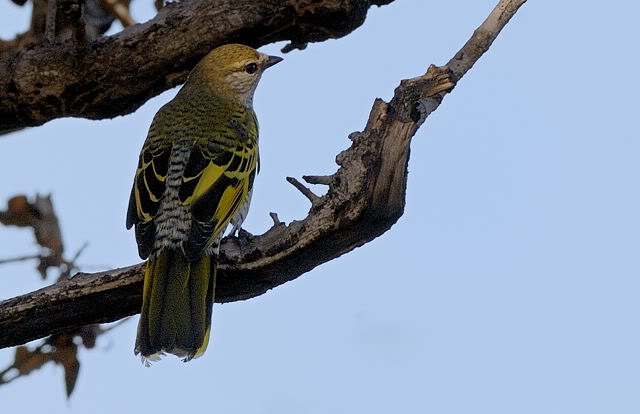 © Dewi
© Dewi
Female
Links:
Species text in The Atlas of Southern African Bird
Sabap2
 © Dewi
© DewiFemale
Links:
Species text in The Atlas of Southern African Bird
Sabap2
Kgalagadi lover… for ever
https://safrounet.piwigo.com/
https://safrounet.piwigo.com/
Family Laniidae (Shrikes)
Shrikes are passerine birds of the family Laniidae. The family is composed of thirty-one species in three genera. The family name, and that of the largest genus, Lanius, is derived from the Latin word for "butcher", and some shrikes are also known as "butcher birds" because of their feeding habits.
Other species, popularly called "shrikes", are in the families: Prionopidae, helmetshrikes. Malaconotidae, puffback shrikes, bush shrikes, tchagras and boubous. Campephagidae, cuckoo-shrikes. The Prionopidae and Malaconotidae are quite closely related to the Laniidae, and were formerly included in the shrike family. The cuckoo-shrikes are not closely related to the true shrikes. The Australasian butcherbirds are not shrikes, although they occupy a similar ecological niche.
Most shrike species have a Eurasian and African distribution. They inhabit open habitats, especially steppe and savannah. A few species of shrike are forest dwellers, seldom occurring in open habitats. Some species breed in northern latitudes during the summer, then migrate to warmer climes for the winter.
Shrikes are medium-sized birds, up to 50 cm in length, with grey, brown, or black and white plumage. Their beaks are hooked, like that of a bird of prey, reflecting their predatory nature, and their calls are strident.
Shrikes are known for their habit of catching insects and small vertebrates and impaling their bodies on thorns, the spikes on barbed-wire fences or any available sharp point. This helps them to tear the flesh into smaller, more conveniently-sized fragments, and serves as a cache so that the shrike can return to the uneaten portions at a later time.
Shrikes are territorial, and these territories are defended from other pairs. In migratory species a breeding territory is defended in the breeding grounds and a smaller feeding territory is established during migration and in the wintering grounds. Where several species of shrike exist together competition for territories can be intense.
Shrikes make regular use of exposed perch sites, where they adopt a conspicuous upright stance. These sites are used in order to watch for prey items and to advertise their presence to rivals.
The shrikes are generally monogamous breeders, although polygyny has been recorded in some species. Co-operative breeding, where younger birds help their parents raise the next generation of young, has been recorded in both species in the genera Eurocephalus and Corvinella as well as one species of Lanius. Males attract females to their territory with well stocked caches, which may include inedible but brightly coloured items. During courtship the male will perform a ritualised dance which includes actions that mimic the skewering of prey on thorns and will feed the female. Shrikes make simple, cup-shaped nests from twigs and grasses, in bushes and the lower branches of trees.
Other species, popularly called "shrikes", are in the families: Prionopidae, helmetshrikes. Malaconotidae, puffback shrikes, bush shrikes, tchagras and boubous. Campephagidae, cuckoo-shrikes. The Prionopidae and Malaconotidae are quite closely related to the Laniidae, and were formerly included in the shrike family. The cuckoo-shrikes are not closely related to the true shrikes. The Australasian butcherbirds are not shrikes, although they occupy a similar ecological niche.
Most shrike species have a Eurasian and African distribution. They inhabit open habitats, especially steppe and savannah. A few species of shrike are forest dwellers, seldom occurring in open habitats. Some species breed in northern latitudes during the summer, then migrate to warmer climes for the winter.
Shrikes are medium-sized birds, up to 50 cm in length, with grey, brown, or black and white plumage. Their beaks are hooked, like that of a bird of prey, reflecting their predatory nature, and their calls are strident.
Shrikes are known for their habit of catching insects and small vertebrates and impaling their bodies on thorns, the spikes on barbed-wire fences or any available sharp point. This helps them to tear the flesh into smaller, more conveniently-sized fragments, and serves as a cache so that the shrike can return to the uneaten portions at a later time.
Shrikes are territorial, and these territories are defended from other pairs. In migratory species a breeding territory is defended in the breeding grounds and a smaller feeding territory is established during migration and in the wintering grounds. Where several species of shrike exist together competition for territories can be intense.
Shrikes make regular use of exposed perch sites, where they adopt a conspicuous upright stance. These sites are used in order to watch for prey items and to advertise their presence to rivals.
The shrikes are generally monogamous breeders, although polygyny has been recorded in some species. Co-operative breeding, where younger birds help their parents raise the next generation of young, has been recorded in both species in the genera Eurocephalus and Corvinella as well as one species of Lanius. Males attract females to their territory with well stocked caches, which may include inedible but brightly coloured items. During courtship the male will perform a ritualised dance which includes actions that mimic the skewering of prey on thorns and will feed the female. Shrikes make simple, cup-shaped nests from twigs and grasses, in bushes and the lower branches of trees.
Family Laniidae (Shrikes) Index
Family Laniidae (Shrikes)
Urolestes melanoleucus Magpie Shrike 735
Eurocephalus anguitimens Southern White-crowned Shrike 756
Lanius souzae Souza's Shrike 734
Lanius collurio Red-backed Shrike 733
Lanius minor Lesser Grey Shrike 731
Lanius humeralis Northern Fiscal
Lanius collaris Southern Fiscal 732
Note: Common Fiscal (aka Fiscal Shrike) is now split into two species (Fuchs et al 2011): Northern Fiscal (Lanius humeralis) and Southern Fiscal (Lanius collaris)
Urolestes melanoleucus Magpie Shrike 735
Eurocephalus anguitimens Southern White-crowned Shrike 756
Lanius souzae Souza's Shrike 734
Lanius collurio Red-backed Shrike 733
Lanius minor Lesser Grey Shrike 731
Lanius humeralis Northern Fiscal
Lanius collaris Southern Fiscal 732
Note: Common Fiscal (aka Fiscal Shrike) is now split into two species (Fuchs et al 2011): Northern Fiscal (Lanius humeralis) and Southern Fiscal (Lanius collaris)


